


Game Eight Alternate Histories Spreadsheet
One of the recurring features of past seasons of AI Survivor have been our "alternate histories", running additional iterations on the same maps to see if the same events would play out again. Game Eight was characterized by Louis leading from start to finish, slapping Huayna Capac down into the Wildcard game with a last-minute attack before winning a Cultural victory. Was that something which would unfold in each game? This was a topic that called for more investigation with alternate history scenarios. Following the conclusion of previous seasons of AI Survivor, I had gone back and investigated some of the completed games and found that they tended to play out in the same patterns over and over again. While there was definitely some variation from game to game, and occasionally an unlikely outcome took place, for the most part the games were fairly predictable based on the personality of the AI leaders and the terrain of each particular map. Would we see the same patterns play out again and again on this particular map?
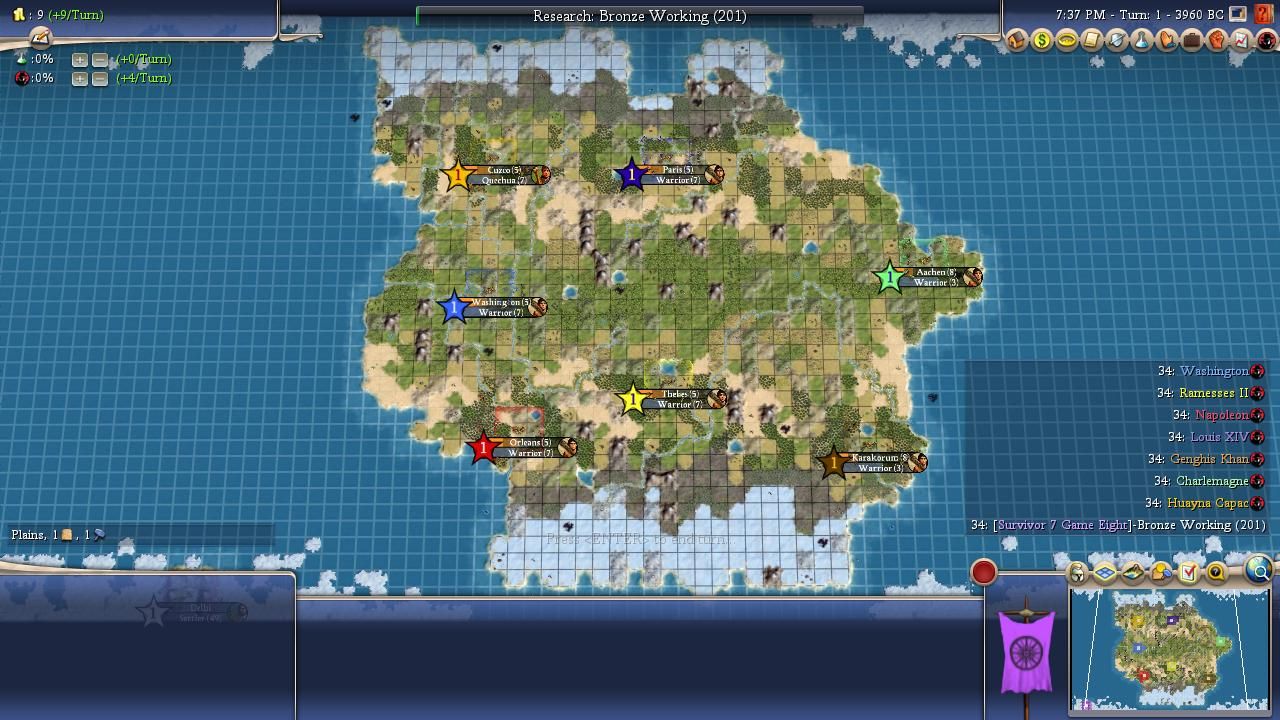
The original inspiration to run these alternate histories came from Wyatan. He decided to rerun the Season Four games 20 times each and publish the results. The objective in his words was twofold:
- See how random the prediction game actually is. There's a natural tendency when your predictions come true to go "See! Told you!", and on the contrary to dismiss the result as a mere fluke when things don't go the way you expected them to (pleading guilty there, Your Honour). Hopefully, with 20 iterations, we'll get a sense of how flukey the actual result was, and of how actually predictable each game was.
- Get a more accurate idea of each leader's performance. Over 6 seasons, we'll have a 75 game sample. That might seem a lot, but it's actually a very small sample, with each leader appearing 5-10 times only. With this much larger sample, we'll be able able to better gauge each leader's performance, in the specific context of each game. So if an AI is given a dud start, or really tough neighbours, it won't perform well. Which will only be an indication about the balance of that map, and not really about that AI's general performance. But conversely, by running the game 20 times, we'll get dumb luck out of the equation.
Wyatan did a fantastic job of putting together data for the Season Four games and I decided to use the same general format. This particular set of alternate histories were run by Slashin' - many thanks for spending so much time on this task!  Amicalola posted the resulting data from the alternate histories and then discusses some of the findings below in more detail. Keep in mind that everything we discuss in these alternate histories is map-specific: it pertains to these leaders with these starting positions in this game. As Wyatan mentioned, an AI leader could be a powerful figure on this particular map while still being a weak leader in more general terms. Now on to the results:
Amicalola posted the resulting data from the alternate histories and then discusses some of the findings below in more detail. Keep in mind that everything we discuss in these alternate histories is map-specific: it pertains to these leaders with these starting positions in this game. As Wyatan mentioned, an AI leader could be a powerful figure on this particular map while still being a weak leader in more general terms. Now on to the results:
Game One | Game Two | Game Three | Game Four | Game Five
Game Six | Game Seven | Game Eight | Game Nine | Game Ten
Game Eleven | Game Twelve | Game Thirteen | Game Fourteen | Game Fifteen
Game Sixteen | Game Seventeen | Game Eighteen | Game Nineteen | Game Twenty
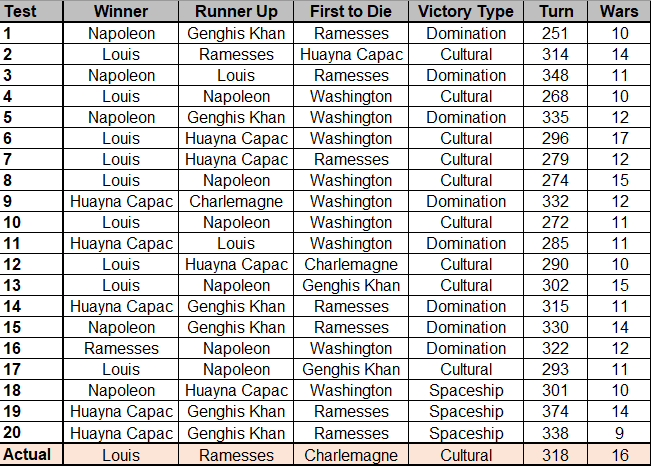

(Note : "A" column tracks the number of war declarations initiated by the AI, "D" the number of times the AI is declared upon, "F" the points for finish ranking, and "K" the number of kills.)
Slashin': Game 8 was one of the games this season I was most curious about given repeated playthroughs. I believed there were some very interesting map dynamics in play that would make for an interesting game, and I was especially curious which leader would be the likeliest runner-up for that sweet playoff 1 starting position. The community placed most of their faith in Huayna Capac and Louis for their predictions, and this faith was vindicated as the two leaders emerged as major players in the actual game. With 20 repetitions, how would the map play out? Would Ramesses be able to consistently place? Would Louis be as dominant in the alternate histories as he was in the actual game or would he share his throne? Could any of the other leaders find victory against all odds? These were but a few of the questions I set to find out.
There are three key map features to understand how game regularly played out on this map.
The Timer
Over the course of the playthroughs, three leaders emerged as dominant in these games while the other four found themselves caught in the crossfires. One of these leaders has to be discussed in the prelude to understand one of the major game dynamics: Louis XIV. Louis was the most dominant leader on this map, and every game (rather appropriately) orbited around the actions of the Sun King. The community correctly identified Louis's incredible starting position, a rich capital with riverside wet corn and riverside gold that always manifested in an incredible tech edge and productive surrounding land that his early cities would utilize to great effect. The raw food/hammer/commerce advantage the purple French enjoyed was absolute, always coming out of the landgrab phase with an uncontested score lead and beaker rate. While Louis would rarely get one of the first two religions, it wasn't uncommon for Louis to found 4 or 5 of the remaining religions thanks to his raw beaker output, and this resulted in Louis turning on the culture slider in nearly every single game. This put an incredibly oppressive timer on the game, and no other leader even remotely had a shot at winning without addressing the French despot. Seriously, look at some of these game end dates: T268, T272, T274, T276 all by culture. A peaceful win condition by anyone else was all but impossible, and domination was the only other win condition to get major representation as it involved crippling the purple French in some capacity. Only three other leaders were capable of sabotaging the French, with the remaining three leaders abetting these leaders through the concession of their territory.
The Two Diplomatic Phases of the Game: High Peaceweight Collapse and Low Peaceweight Conflict
Peaceweight was the key factor for tensions in the first half of these games, and the high peaceweight leaders were the unfortunate victims of dogpiles game after game. The high peaceweight leaders were outnumbered three to four and unfortunately, their central map positions ensured they were the recipients of war declarations from all sides. Washington, Ramesses, and Charlemagne were attacked relentlessly every game and while most of the time they could fend off the invaders early on, they'd eventually collapse by sheer weight of numbers. So many games started with a low peaceweight leader initiating a conflict with a high peaceweight leader, and when the high peaceweight leader would start turning the tables of a conflict, they would get sucker punched by another aggressive neighbor while the bulk of their units were elsewhere. The ridiculously lopsided offensive/defensive war ratios tell the story of this game: Washington 47 defensive wars compared to 6 offensive wars, Ramesses 53 defensive wars to 12 offensive wars, and Charlemagne 43 defensive wars to 19 offensive wars! The low peaceweights benefitted massively from gaining mutual military bonuses with each other, often ending up pleased with each other despite differing religions and border tension when they otherwise might have been at cautious.
As each high peaceweight was eliminated, the remaining high peaceweights would be increasingly dogpiled and inevitably eliminated. The one exception involved Huayna Capac and Louis, who often had massive border tension and separate religions that would be just enough to bring each down to cautious at something like -3. Despite these two fighting frequently in the early game however, they would end up pleased in the midgame where shared civics would be sufficient to keep each other happy. As a result, there were two distinct phases to this map that could be characterized by the diplomatic situation. The first phase of the game was characterized by the evil leaders eliminating the good leaders in the middle of the map and consolidating their holdings, which depending on how it was partitioned, would determine how the second phase played out. The second phase of the game involved 4 pleased/cautious low peaceweight leaders that would inevitably turn on each other thanks to all being capable of declaring at pleased. The most common conflicts rose among sources of new border tension, with Huayna Capac and Napoleon battling for western hegemony while Louis and Genghis fought for the East. Huayna Capac and Napoleon would often battle due to the new cultural tension Huayna Capac put on Napoleon's newly acquired American holdings, and this conflict usually determined who would be the runner up. Genghis vs Louis was the other typical conflict in the second phase, and was pivotal in many games for determining whether Louis's bid for culture would be stopped. That being said, HC/Louis, Napoleon/Louis, Napoleon/GK definitely had their share of conflicts when the dice roll called for it or if mutual religions and military struggles could get the leaders normally at odds to friendly. Nevertheless, HC/Napoleon and Louis/GK were the two most common conflicts in this phase, and often ended up with Louis taking home the medal while one of the other leaders took the runner up prize.
The Copper Haves vs Have-nots
This map featured four leaders with guaranteed copper within their capital BFC: Huayna Capac, Louis, Charlemagne, and Genghis Khan. These four leaders almost always initiated the first conflicts on the map, and their early access to copper led to some very early war declarations that would be mutually destructive for the parties involved. A few examples include GK declaring on Ramesses on T54 in G1, GK declaring on Ramesses on T63 in G3, HC declaring on Washington on T65 in G8, HC declaring on Washington on T63 in G18 and so on. On the flipside, Rammeses, Washington, and Napoleon would have to rely on Iron to get access to metal units, and even that wasn't a guarantee in Ramesses and Washington's case! If it wasn't for Ramesses having access to the War Chariot, I'm convinced he would have been the runaway favorite for first to die. Ramesses was incredibly fortunate in the actual game to never be targeted by Napoleon and dodge an early war declaration from Genghis Khan, as many alternate histories featured Ramesses being ran over by both due to a lack of early metals. Ironically, the biggest beneficiary of this resource setup was Napoleon who benefitted enormously from his neighbors being weakened by stalemated wars and not targeting him instead. Without the sweet allure of early copper to bring the southern French into an early plotting period, Napoleon consistently developed his economy and built up a healthy core from which to amass his armies and sucker punch a neighbor involved in a conflict with one of the aforementioned copperdec civs. This was a very aggressive map with many war declarations as a result.
With that out of the way, let's move on to the individual leader performances.

Louis of France
Wars Declared: 38
Wars Declared Upon: 35
Survival Percentage: 55%
Finishes: 9 Firsts, 2 Seconds (49 points)
Kills: 13
Overall Score: 62 points
Louis le Grand indeed. Despite Louis and Napoleon getting the same score on this map, Louis gets first mention due to the impact he had on this game. Louis was a juggernaut on this map and as previously mentioned, put a short clock on every game. Every single one of Louis's wins came from culture, while the rest of the games involved the French King trying and failing. He behaved like a 90's era movie bully, swelling up to a dominant position in the early game and daring any of the other leaders trying to catch up to come at him. Louis always came out of the land grab phase as the score leader (think 1300 while everyone else is around 800) with a high city count, high quality cities, and high beaker rate. This was owed in part to his incredibly strong capital, featuring a riverside gold and corn, and Louis always made good use of his early workers thanks to his starting techs. It wasn't just the capital however, as his 2nd and 3rd cities were always on the fertile flood plains river valley south of Paris with plenty of flood plains, cereal grains, and AH resources to improve. Louis being creative was also a big boon here, and allowed Louis to aggressively settle and claim a ton of space as he often snapped up the lion's share of territory between him and a struggling Charlemagne. He almost always claimed the early marble wonders such as the Oracle, ToA, and Mausoleum that not only provided powerful early economic benefits but also facilitated his culture bid down the road. In most games, Louis would build up to a 9-10 city core in the landgrab phase naturally, scoop up most of the wonders, and lead in research. He leveraged his early capital gold on getting a jumpstart on early game worker techs and cottaging his fertile core to snowball ahead in tech. In most games, Louis would be lapping the field in terms of tech, and this proved key for his win condition as it allowed Louis to regularly scoop up all the classical and medieval religions to fuel his early culture wins.
Louis's position was further strengthened by the relative weakness of his neighbors and he took advantage of his strong starting position to lock games down early. His best games were when he targeted Charlemagne, who always struggled mightily in the early game and failed to consistently build a Christian coalition with hie neighbor. Charlemagne never put up much resistance in most of these conflicts and if Louis absorbed his neighbor, the game was basically a locked Northern French win. This happened in G8, G12, and G17 where a runaway Louis was basically content to tech off 2-3 empires worth of land as the rest of the world watched helplessly as the timer ran out. Louis also found success when he opted to go for Ramesses, often joining in on dogpiles and partitioning Egyptian territory with the Mongols and Napoleon. In addition, Louis backdoored his way to a few wins in games where other ais would being to snowball and ignore Louis in favor of attacking each other. Huayna Capac, Napoleon, or Genghis would begin consolidating the rest of the map, only for the game to declare Louis the victor. G4, G6, G10, and G13 all featured this style of Louis victory, and showcased in full force the dangers of a culture leader that gets along with the most vicious of leaders in the game. It was no coincidence that Louis placed in every single game he survived until the end to, and he displayed his dominance in full force these games.
That said, for all the success he enjoyed, Louis wasn't infallible as he was eliminated in 9 out of 20 games. Louis's greatest flaw is one the community is well aware of: himself. For a leader that loves to pursue culture and spam wonders in every build queue, he found himself mired in a lot of wars where he really should have been able to take more territory in a quicker fashion. However, Louis often found himself stalemated in situations he really should not have been, such as getting stuck on cities against leaders half his score or a full tech era behind in military technology. Louis's high aggression was further exacerbated by having copper in his capital, and would sometimes plot extremely early when the landgrab was still incomplete, hindering his long-term potential. This led to some of his worst games, where Louis would copperdec Huayna Capac early on due to differing faiths and border tension, when they really should have been game-long allies. The two only differ by 1 in PW, share 2 warmonger respect, and share the same favorite civic for heaven's sake, and still found themselves fighting each other when they managed to reach cautious relations at -3. This resulted in a mutually destructive war and set the stage for conflict in the modern era once one switched out of HR. Louis would still usually be the score leader after this happened, but it considerably closed the gap he had with the rest of the field in these games and set diplomatic issues far in the future, where he would be subject to a HC/GK 2v1 or something similar that would eliminate him.
Louis was also a victim of his own success and these defeats were much more damning. Louis. having double culture traits and regularly getting 3-4 religions thanks to his research rate, went culture in nearly every game. Whereas his wins showed the dangers a leader that reliably goes culture poses to the game, his losses showed the flipside of the risks inherent in pursuing culture in an incredibly hostile world. Many of Louis's defeats had him at the top of the scoreboard with an advantage in every conceivable metric, only to turn on the culture slider at physics/replaceable parts/ chemistry or whatever without rifling. He'd often turn this slider on when his third city was still at 4-digit culture levels, and this left a huge window of time for multiple ais who did have rifling tech to jump in and stop his culture bid cold. Sure, he may have been pleased with HC, GK, and Napoleon but given they were all pleased or friendly with each other as well at this phase of the game, Louis was still repeatedly attacked by his fellow low PWs. Genghis Khan was the most common opponent to face in the lategame but it wasn't uncommon either for Napoleon or HC to step in as his ballooning cultural borders made him an enticing target for these leaders. The most damning example of this was G15, a game where Louis was a full 1500 points ahead of Napoleon, yet refused to give up his culture bid as he caved to Napoleonic era rifles and cannons while on medieval tech. Other games, Louis's early skirmishes with HC would bite him in the butt as once Free Religion and favorite civic diplo modifiers were removed, they would only be cautious with each other in the lategame amidst a sea of pleased faces. The same story played out, with Louis regularly turning on the slider during a war and slowly losing ground once either HC got the tech edge or he was invariably dogpiled. GK was also a pest in these games, being the most likely to declare war on Louis after the high PWs were eliminated, and gave the French leader a good shellacking such as in G14. These games showed the risks to culture in a very hostile environment, and I suspect had Louis simply gone space every game, he would have likely won around 80% of the time. Nevertheless, Louis proved himself a very dangerous leader this game and shifted community perceptions about him with his remarkable performance in the live game. This game made it clear how dangerous a low PW leader that gets ignored by the more militaristic ais and pursues culture while being willing to expand through militaristic means can be.
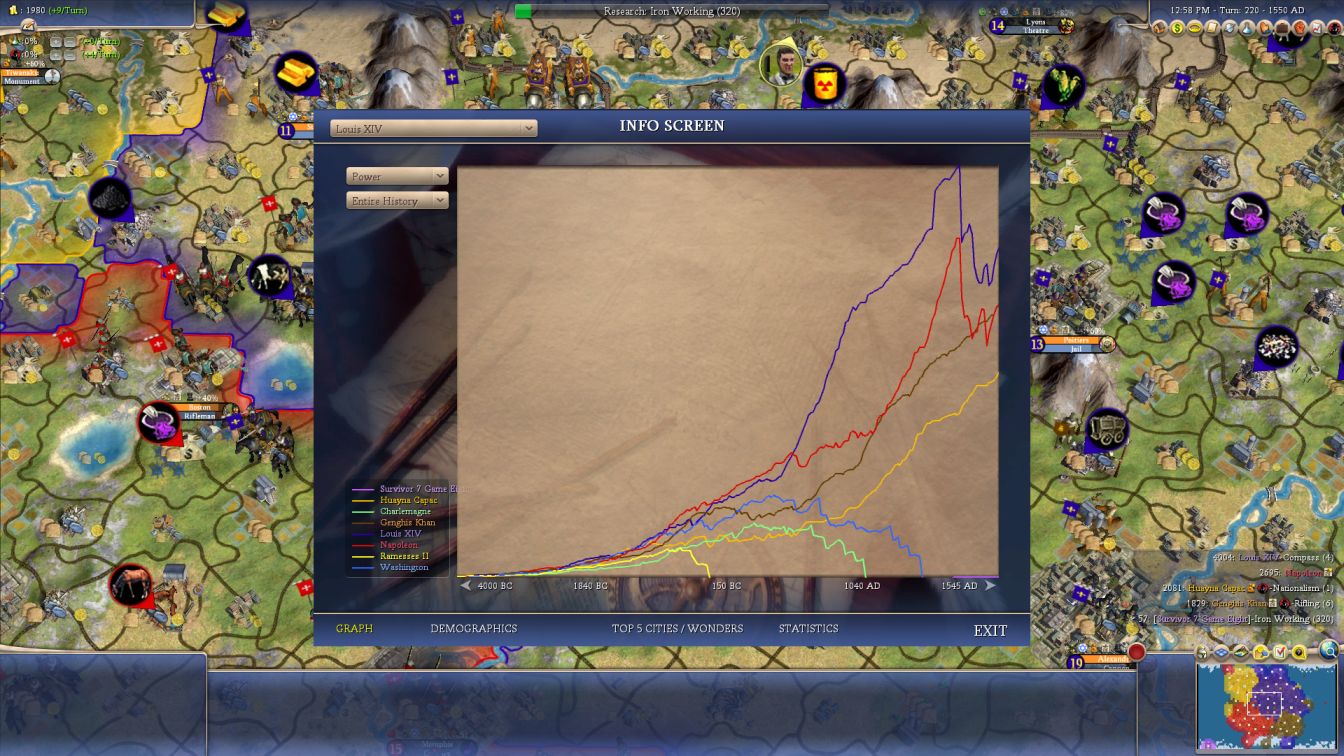

Napoleon of France
Wars Declared: 59
Wars Declared Upon: 20
Survival Percentage: 75%
Finishes: 5 Firsts, 6 Seconds (37 points)
Kills: 25
Overall Score: 62 points
And then there was the other French leader, who continues his now 3 season streak of disappointing in the live game while proving a monster in the alternate histories. Whereas Louis dominated the cultural landscape over in Versailles, Napoleon encompassed the actual landscape in bright red borders with successful military campaigns. Napoleon won three out of the first five games, and I thought we may have missed out on a juggernaut before a nine-game streak of Louis and Huayna Capac victories brought him back down to Earth. Nevertheless, Napoleon was a surprisingly effective leader on this map and against all odds managed to tie Louis for overall scoring. This was genuinely a shocking outcome to me, someone who had the French general on his fantasy team, and anticipated he had a decent shot at runner up, but never outright winning the game. After all, Napoleon was situated in a cramped corner, with hostile neighbors, and relatively poor terrain outside his immediate vicinity. As a hyperwarmonger with poor local terrain, it seemed that Napoleon would be relegated to irrelevancy fighting a few wars before ideally piggybacking on the back of the runaway or making it to the wildcard.
Napoleon's success can be attributed to the major map dynamics in play mentioned earlier and France's starting techs. First let's start with starting techs, as it's Napoleon's biggest ace over other comparable warmongers. Whereas militaristic leaders like Boudica, Ragnar, and Genghis Khan regularly trip over themselves with terrible tech paths in the early game that handicap their game, Napoleon is blessed with agriculture/wheel starting techs, and that meant Napoleon could do no wrong when it came to early game research queues. Perform the military beeline of archery into bronze working? No problem! He'll go ahead and farm these flood plains to push settler development and connect his second city. And while Napoleon's terrain as a whole was not very good, he did have very powerful local terrain around his capital and to the north, with ivory and flood plains to fuel early game development and a gold tile in capital BFC to speed up research. Hunting and mining were always prioritized early by Napoleon, giving much needed happiness and commerce to the southern French leader. Napoleon frequently did the military leader thing of skipping mysticism, and would often find his cities culturally crushed in the early game by Ramesses but would still find workable tiles that were improved and still grow large. Cultural pops were never too far away for the French general anyway, as he would eventually tech to writing for libraries quick enough thanks to his decent teching prowess from working the gold. Napoleon's lack of copper ended up being a blessing, rarely finding himself the target of an early war declaration from his neighbors. Instead, he focused on expansion and development without being tempted into early wardecs himself. Napoleon consistently developed to 7-9 cities, and while not all these cities were winners in terms of placement, an extra production queue is always valuable for a leader revving up the war machine. Of course, once Napoleon actually hooked his metal resources, he became the insane offensive warmonger we love to see, engaging in 59 offensive wars versus 20 defensive wars.
Second, the map dynamics in play benefitted Napoleon the most out of all the leaders. In a 1v1, Napoleon actually had difficulty taking land and would often get outpaced by the superior food/hammer capabilities of Washington or Ramesses, lacking the ability to punch through and take further territory before Construction much like we witnessed in the actual game. In the alternate histories however, Washington and Ramesses found themselves the constant targets of copperdecs from other neighbors. In Washington's case, Huayna Capac copperdecced him very early on in the majority of games, often stalling out and resulting in units being lost in droves on both sides. In Ramesses case, Ramesses found himself the victim of war declarations from Genghis Khan or Louis, who both regularly plotted early due to their bfc copper. Napoleon as a result of not having easy access to copper, would regularly wait until after other leaders had weakened his neighbors and then swoop in for the finishing blow while opponent stacks were elsewhere. This allowed him to snipe border cities after the initial wardec with an enormous stack while also being relatively close to Construction to lay the smackdown on his neighbors remaining cities shortly after. This happened countless times versus Washington, where HC or Washington would instigate fights with each other due to copperdecs or border tension, and Napoleon would come in halfway and take over 2 American cities off the bat, then conquer the rest after Construction splitting them up with HC, such as in G5.
However, Napoleon found more success when he declared on Ramesses first after GK or Louis would attack him and then clean up a good portion of Egyptian cities for himself often with a holy city to boost research. Napoleon also found success however when he 1v1'd Ramesses, as oftentimes Napoleon came in with metal units while poor Ramesses could only field war chariots and archers, leading up to a completely dominant snowball. This happened in g1, where Napoleon solo killed Ramesses and achieved a t251 domination victory. Napoleon's immediate diplomatic situation also was surprisingly good in many games. In games where Napoleon and Ramesses shared religions, Ramesses would almost always be pleased with Napoleon getting something like +10 from civics and religion alone. Other games, Washington, HC, and Napoleon would share a religion and Napoleon would be free to conquer without fear of reprisal from his neighbors. This helped Napoleon a ton where he could conquer one of his neighbors while the other was pleasedlocked with him, and Napoleon would inevitably conquer the other and transform into a major contender. It was quite fun seeing the diplo shake out where Napoleon despite having the most lopsided peaceweight on the map found himself on quite good terms with everyone (or at least whomever was left).
Napoleon's more mediocre games were usually when he attacked Washington before HC did or Washington attacked him first, preventing him from breaking out. Napoleon's starting territory was not sufficient to facilitate a peaceful win condition, having less land and premium terrain available to him compared to other leaders. When Napoleon failed to snowball off land or have enough land to contest the other major powers, he would lose the lategame conflicts versus HC or Louis. The actual game actually represented this dynamic very well, where HC and Napoleon fought and Napoleon lost the battle between the two as his armies were marching off to conquer GK. It was common to see HC win the duel if Napoleon didn't siphon territory from both his neighbors, and HC would win having a food/production/tech edge that Napoleon could not overcome. Other games, Napoleon would be well on his way to a domination victory, only for the game to end because one of his targets early on didn't happen to be Louis. G4, G10, and G13 were all examples of this, showcasing a runaway Napoleon losing once Louis hit 3 legendary cities.
In spite of that, Napoleon's performance on this map was very impressive given his cramped and relatively weak starting position. It was fascinating seeing how Napoleon gamed the diplomacy to his advantage game after game, even if it was more a technicality of map dynamics and subsequent interactions rather than actual planning. Napoleon may not be able to leverage the best starts to their full potential like HC or Mansa might, but he can certainly break out of mediocre ones and that's a big deal. He needed a lot of things to go right and he exploited the map dynamics and diplomacy enough times to make that consistently happen. It was a good showing by the French general.
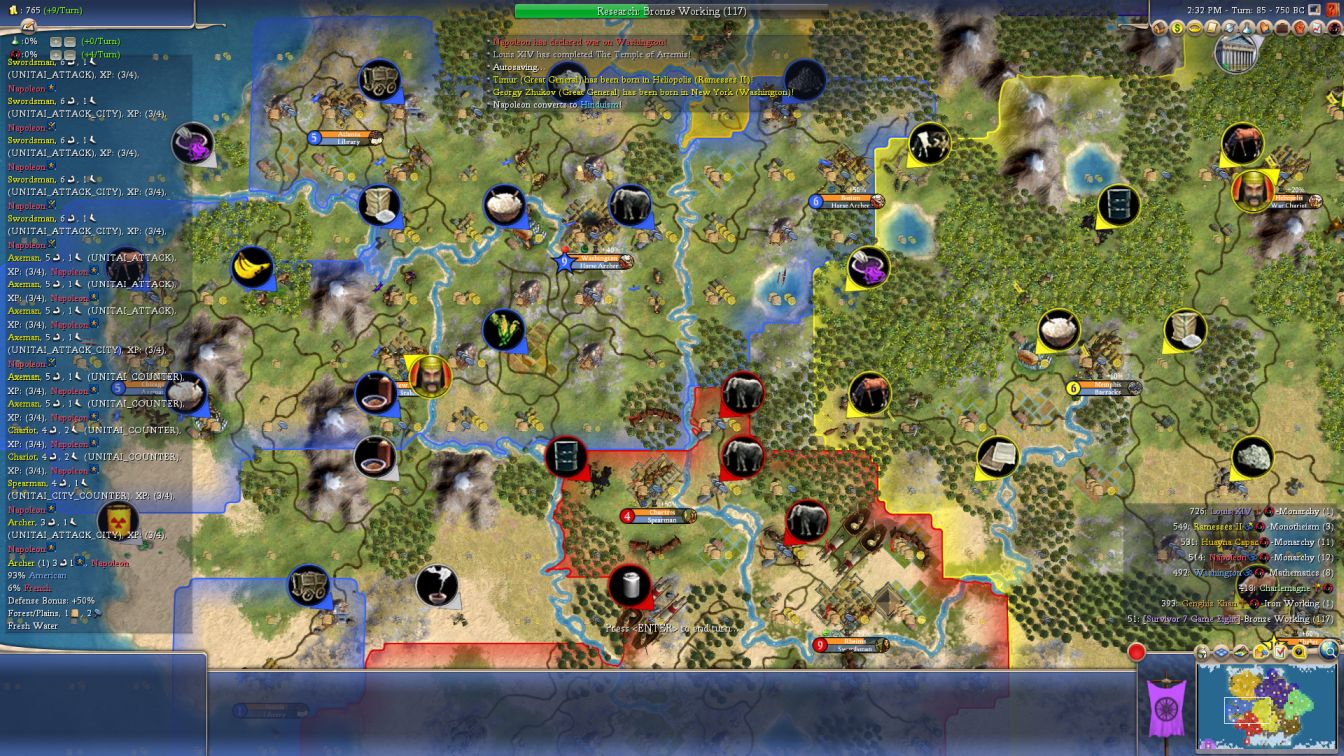

Huayna Capac of the Incas
Wars Declared: 45
Wars Declared Upon: 27
Survival Percentage: 80%
Finishes: 5 Firsts, 4 Seconds (33 points)
Kills: 19
Overall Score: 52 points
The final and least French of our power trio on this map was Huayna Capac. HC was heavily backed by the community for the actual game and the results of the AH showed this was well justified. HC lacked the gold resource the French leaders had and was slower as a result. HC regularly nabbed one of the early religions but would lose any subsequent religions to Louis. This precluded any chance of a culture victory as Louis picked up all the later religions and assumed the timer role that HC was expected to take in the live game. As a result, HC's victories were always by domination or space, usually initiated by taking over part of Washington's territory and winning the conflict vs Napoleon. It didn't take much either for HC to get to this stage, as his starting land was overall the second strongest on the map, and he would have enough room to expand to 10-11 cities at the end of the landgrab and outcompete leaders who had not snowballed by then. Otherwise, he still found himself placing in a decent number of games behind Louis when the two got along in their games after triumphing over Napoleon.
That said, my read on these games was that HC underperformed quite heavily relative to his starting position, and he was capable of being much stronger than he actually was. HC had one major Achilles heel in this game and that was his overaggression. HC was one of the leaders to have copper in his capital BFC this game, and this showed as he copperdecced Washington over and over again. HC's second city usually was placed south and would touch Washington's capital borders very early on with the help of an early religion and terrace culture. HC usually ended up declaring wars right around when Washington would hook up iron, and the usual result was that the two would waste production on early units that would suicide into their opponent's border cities when they should really have been expanding or building infrastructure. In games where HC did not initiate the war, he'd find himself on the receiving end of a war declaration as his ballooning culture pressure encouraged Washington to attack HC more often than Napoleon. Huayna Capac spent game after game wasting early game production on fruitless wars, only for Napoleon to later join the war and claim the lion's share of American cities. In this case, HC often did take 2 or 3 American cities for himself like in the actual game, and would the proceed to fill out the rest of his territory with fishing villages that would have otherwise been placed 40 turns before.
HC's other issue was Louis, whom he clashed with in many games. HC's religion never really spread too well in most of these games, and Louis XIV typically found himself in a self-founded religion or one spread by Ramesses or Charlemagne. Louis had copper in his capital bfc as well, and this combined with differing religions and major cultural tension along their borders was just enough to bring both to cautious and start plotting on the other before shared civics could bring them up to pleased. This conflict never did much but bridge the gap between them and the rest of the field, and even when the conflict ended, the two still regularly found themselves at pleased when shared civics came into play. The biggest impact these wars usually had was when Louis would inevitably adopt free religion and one of the two dropped HR as their civic, it would be just enough to drop relations for the one who was declared on to cautious and initiate conflicts in the second phase of the game. This usually led to HC and Louis coming to blows late, which would either result in a Louis win or elimination depending where Louis stopped on the tech tree.
In a way, this showcases the strength of our #1 leader, where he was weakened in every game by fruitless conflicts and still came out ahead in many games once given the chance to recover. These runs support the notion that HC is always a dangerous opponent even when he squanders his opportunities.

Genghis Khan of the Mongols
Wars Declared: 65
Wars Declared Upon: 17
Survival Percentage: 65%
Finishes: 0 Firsts, 6 Seconds (12 points)
Kills: 16
Overall Score: 28 points
What happens when you give an absolutely insane sociopath with a pure military research flavor BFC copper and two neighbors he begins the game annoyed with? Rhetorical question, Genghis Khan needs no pretense for war! GK was batshit crazy on this map and lived only for the thrill of combat. His offensive vs defensive war ratio really speaks for itself, at a staggering 65 offensive to 17 defensive wars. Unsurprisingly, GK's game plan on this map was caveman aggression and unit production queues in every city at the expensive of anything even remotely economic. GK would get out to 5, sometimes 6, cities before pivoting to pure axeman and spear production in all his first ring cities. If it wasn't HC declaring the first war, you bet it was GK blowing the horn as his stacks marched into Egyptian or holy roman territory in hopes of finding an administration that would at least give a cursory glance to the domestic panel. GK's bouts against Egypt usually backfired, as he would usually take 1 city for free but then lose his stack to archers and war chariots huddled up in another city. He would then proceed to waste production on units, as he threw away small stacks bit by bit than amassing a large one, plus he also tended to be on a timer before the Egyptians could connect metals and reverse the war against them with their production edge. It was usually only when someone else joined the fray that GK would be able to get any further progress and failing that, would sign peace only to attack his neighbor to the north two turns later. Speaking of which, Genghis Khan usually found far more success in attacking the Holy Romans first who were utterly incapable in these games. GK would always conquer a few HRE cities from the outset as Charlie often did not have bronze working yet despite starting with copper in his capital. Given time, GK would be able to conquer Charlie in every game 1v1, but this was often facilitated by Louis subsequently declaring war on Charlemagne most games and partitioning the Holy Romans with the northern French.
GK had one constant on this map, and that was his abysmal tech rate. Even after successful conquests, GK still found himself the lowest on the totem pole and regularly emerged the runt after the high peaceweights were eliminated. He often found himself in early medieval while everyone remaining was well into the Renaissance and as a result, was never competitive for winning any of these games. The closest GK came to winning was G19, where a strangely peaceful GK declared his first war on Ramesses after Napoleon did, and it was the Mongols who instead grabbed most of the Egyptian territory and left the French with scraps. He would then proceed to solo conquer Charlemagne and split Louis with HC. However even this game he was never in the contention for victory as HC had conquered the western half by then and launched the spaceship before the Mongols reached assembly line. That said, GK was pretty good at hanging around on this map and playing spoiler in a few games. GK came up as runner up in 30% of games and even though they were distant finishes, he did find he could come behind all 3 of the top leaders on the map. He also survived in 65% games, which was pretty impressive considering he did help play spoiler to Louis's culture bid such as in G19, where he dogpiled onto Louis alongside HC to secure his runner up position.
GK had a decent shot of surviving thanks to mutual military bonuses and low peaceweight, but was never in a position to win. Still, that's much more than can be said than of the bottom three leaders on this map.

Ramesses of Egypt
Wars Declared: 12
Wars Declared Upon: 53
Survival Percentage: 15%
Finishes: 1 First, 1 Second (7 points)
Kills: 3
Overall Score: 10 points
In the actual game, Ramesses's tenacity holding against Louis and broship with Napoleon secured him a second-place finish. This was an unlikely outcome given multiple iterations of the map and Ramesses fell under constant assault on all three sides in most games. Ramesses had two big issues: Diplomacy and lack of early metals. Ramesses was quite good at sharing his faith whether self-founded or adopted with his neighbors but it didn't matter and actually backfired in most cases. Ramesses would find himself the target of a copperdec to the North and East in most games and he always had difficulty holding these off due to lacking metals, although he could stall his demise until he got access with a combination of archers and war chariots. In games where his religion took off, it made him a less desirable target early on as his neighbors had other high peaceweight targets to go for, but it would never fully protect him and even locked him out of potential conquest opportunities when they presented themselves. In these games, Ramesses would find himself pleased-locked by shared civics and faith while his neighbors remained cautious at +5 or +6 due to lower base diplo and no shared civics. It simply just meant Washington and Charlemagne would go out first, before the rest of the world inevitably dogpiled the Egyptians to complete the first phase of the game. The other issue was Ramesses lack of nearby copper and iron, and there were many games Ramesses was brutally punished for this. Sure, he could stop the sporadic GK stack, but then Napoleon would jump in from the other side with a 20 sword/spear/axe stack and 3 archers and 8 war chariots simply couldn't handle that. Ramesses desperately needed metals to hold and the games he was able to access it he held out for much longer, but he'd inevitably fall to the collective fury of the low PWs. Ramesses managed to secure one first place finish in an unusual game where he avoided attacks from both Frances and attacked GK who was consolidating Charlemagne, taking both Mongolian and former HRE land in the process. He then fought with Louis and overwhelmed him while Napoleon shared his faith and consolidated Washington and HC. Ramesses proceeded to win a domination victory incidentally when toggling the cultural slider. However, this was very much the exception and most of the time, Ramesses found himself in a hopeless diplomatic situation that ended up with his territory annexed into one, two, three, and even four principalities.

Charlemagne of Holy Rome
Wars Declared: 19
Wars Declared Upon: 43
Survival Percentage: 15%
Finishes: 0 Firsts, 1 Second (2 points)
Kills: 2
Overall Score: 4 points
Burger King was the most disappointing leader on this map. Charlemagne had access to excellent terrain, a grassland gems in capital BFC, and the chance to curry diplomatic difficulties with religion. Instead, he flubbed game after game due to poor economic development. Charlemagne was slow out of the gate, and almost always pursued a religion before grabbing food techs. He delayed connecting his resources by a significant margin by pursuing religious techs and archery before any meaningful worker techs, and this was worsened whenever he lost the race to a religious tech with HC and went for the other one afterwards. Take this screenshot for instance:
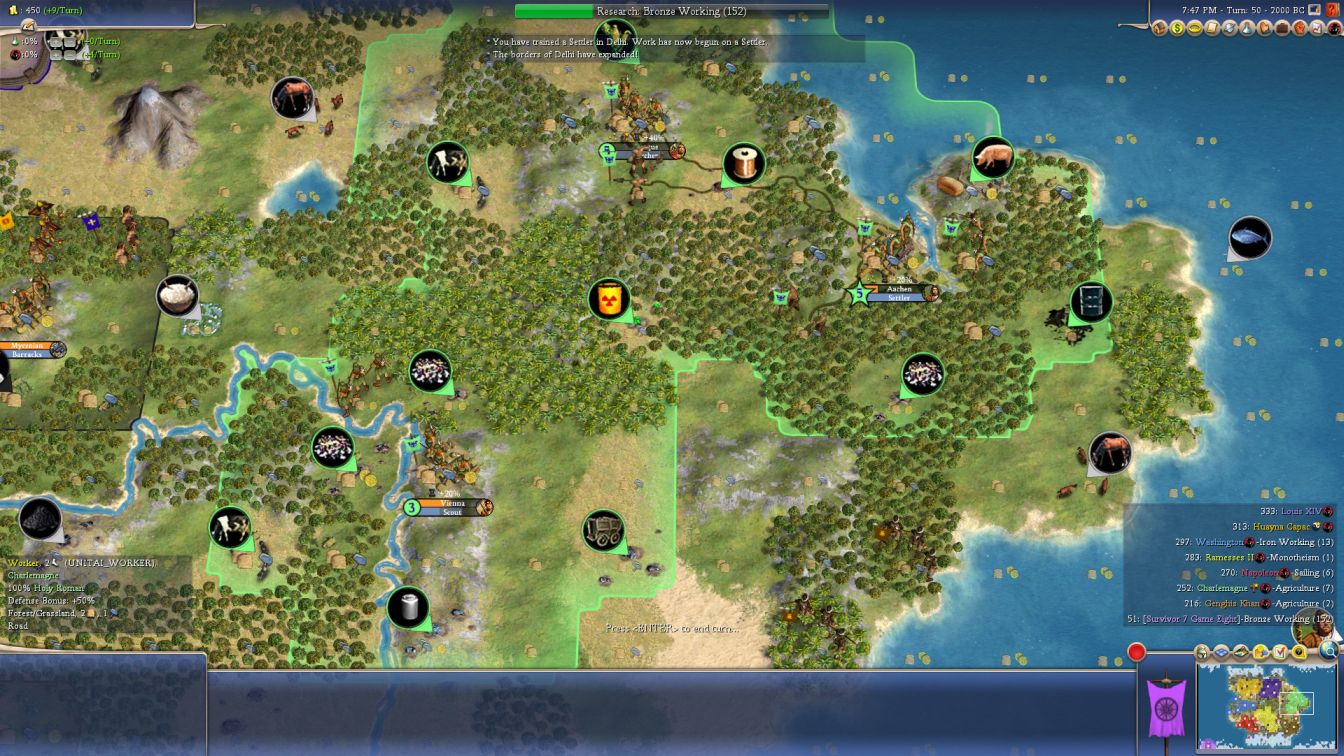
In 50 turns, Charlemagne managed to improve all of one pigs tile and a few roads, on 3 cities, just beginning to tech agriculture and had not started mining yet. Meanwhile Louis had gone up to 4 cities, connected all his cities with roads, and had cottages/hamlets being worked on almost all his flood plains tiles. This wasn't a slow start either, and had Charly opted to open mining to work the gems tile while also working the food neutral pigs hill tile with a mine at the start, I believe he very well could have been a powerhouse on this map. Charlemagne was regularly attacked by both of his neighbors in these games and it was usually game when either attacked. Most games, the teaming wasn't even necessary. Genghis Khan regularly attacked Charly first with a copperdec and would inevitably win the 1v1 given time, as Charlemagne could never connect his copper quickly despite being in his BFC. A Louis war declaration would almost always be a swift elimination for the Holy Romans. Charlemagne managed one runner up finish in G9 behind Huayna Capac, a distant 2nd where Genghis Khan exhausted himself on Ramesses and Louis was locked in wars with the Incas all game. He had managed to spread his religion to the Incas and came up second via being the last one standing when HC hit the domination limit. Charlemagne was extremely weak on this map and it's a puzzle as to why he was so bad at developing his land. It was a terrible look for the seeded leader.

Washington of America
Wars Declared: 6
Wars Declared Upon: 47
Survival Percentage: 5%
Finishes: 0 Firsts, 0 Seconda (0 points)
Kills: 1
Overall Score: 1 point
Poor Washington performed better than his score would indicate, but his spot between a rock and a hard place doomed the Americans to irrelevance. As discussed in length above, Washington found himself the unfortunate victim of early copperdecs by the Incas in most games and was perpetually in defensive wars. He had the most lopsided ratio of offensive to defensive wars (6 to 47!!!) and there was always someone somewhere on the map that wanted a piece of the American leader. Washington actually played the early game quite well, and leveraged his local terrain well enough that most games found him at a beaker and production advantage over his aggressors early on. He was able to regularly stalemate most wars before construction, and even managed to hold off a few 1v2's early on much like the actual game. It was only a matter of time however when Napoleon or HC would both get construction and stretch his forces thin, or Genghis Khan and Louis would join in due to PW differences once Ramesses and Charlemagne were eliminated. Washington managed to find a stray kill against Napoleon in G2, where after eliminating HC with Louis, he was able to get the last hit on Napoleon with the aid of the Egyptians. This prevented Washington from being completely locked out of scoring and allowed him one game where he managed to survive to the end. In the vast majority of games however, Washington was used as a stepping stone by Napoleon or HC for their own domination bids.

Was the Live Game Typical?
Was the actual game we saw indicative of how the map would regularly play out? Despite Ramesses being the runner up, I would say yes, the actual game was representative of the alternate histories. Louis came out of the landgrab phase as the score and tech leader while Charlemagne failed to expand and develop an economy. We saw Louis and GK engage in ultra early copper decs, and while GK's target was unorthodox, the extreme aggression due to bfc copper access matched the early game dynamics seen in the alternate histories. Washington declaring on HC was entirely typical, as HC's heavy cultural pressure on northern American borders incentivized Washington to declare war on the Inca as opposed to Napoleon in most games. Napoleon's relative passivity, strong commerce, and solid tech rate early on was displayed in full force in the actual game, as he did his best Gandhi impression before hooking up iron at a later date and dogpiling into his neighbors. The first phase of the game played out in standard fashion, with the cleanup of the high peaceweight leaders with the exception of Ramesses whom Napoleon was inexplicably pleased with in the actual game. We even got to see the general trends of the second phase play out, as HC and Napoleon duked for Western supremacy with HC coming out on top in the actual game, and Louis and HC getting into conflict once shared civics and religions were out of the picture. Louis ultimately emerged as the victor, cutting the game short with Napoleon and Huayna even surviving their duel to duke it out in the wildcard!
Fantasy Implications
It turned out Louis was the most likely leader to win the game, so props to Amicalola for spotting that potential for a well-deserved 1st place finish. Louis would eventually become the champion of the entire season and provide the largest point total for any single leader at a whopping 18 points. We have enough alternate history data from season 7 to confirm that Amica's success was no fluke and his excellent drafting strategy led to one hell of a roster. Well played, my man.
I quipped ad-nauseum in the Discord community that Napoleon was my best bid and the one I was most proud of, snapping up the French leader for a paltry 14 gold in fantasy. It turns out my intuition was correct, suck on that doubters! From a value perspective, Napoleon was arguably superior to Louis here who was drafted for 41 gold in comparison, but Napoleon matched Louis in terms of top two finishes while also having a 20% higher survival rate and safer point distribution from a mix of kills and finishes. I have faith that Napoleon would have done very well in either playoff game, and would have especially loved being in playoff G1 in Ramesses's position. Napoleon was a bid for that extremely powerful playoff spot and had he placed, would have likely done well with Monty and Sury to even up the peaceweight distribution of that game. Good job Slashin', and it's a shame it didn't pan out live. I'm sure there's a parallel version of me all smug and insufferable spamming Sulla's discord shortly after the game, so at least the live events spared the community members of that fate.
Nabaxo had the only triple digit bid of 100 gold on Huayna Capac, and while that seemed like an absurd overbid, could have very well paid off. The community's perception of Louis has improved considerably after this season's results, but it's still a comparison through the lens of our #1 leader. Huayna Capac had a solid shot at placing and the highest overall survival rate. Needless to say, Huayna Capac would likely have torn up either playoff game and been favored to take home the season. We could very well have been looking at gold medalist Nabaxo and his XCOM squad carrying him to the podium. Myth had a decent shot of GK making it to that sweet P1 spot, making his team of Cathy and the Crew more competitive in the running. Lastly, Jmie would've lost a vital member of his team that carried him up the bracket in Ramesses, with the more likely outcome of receiving 2 points for his troubles.
- Slashin'



